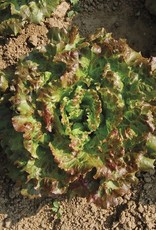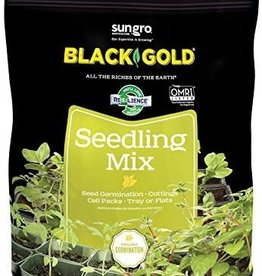HM Lovelock Lettuce 500 SEEDS
| Availability: | In stock (13) |
Photo and Description credit: High Mowing Seed
Days to Maturity: 48 days
Heat tolerant whorls of bright green leaves with deep red coloring on the leaf margins.
Heads close in late at maturity forming a dense, crisp head. Almost identical to Luana with better disease resistance and darker red tinge on the leaves. High Mowing is proud to be the exclusive producer of organic seed for this variety thanks to our partnership with Vitalis Organic Seeds. Available as raw or pelleted seed. A portion of the sales of this variety is paid to the breeder - learn more here.
- Full-size heads
- BR
Disease Resistance Details
High Resistance: Downy Mildew (1-27, 29, 32), Lettuce Mosaic Virus / MTO-30
24,000 seeds/oz avg. M= 1,000, MM=1,000,000
Seeding Rate
Baby Leaf - 96M seeds/100’ bed (~ 4 oz), 960M seeds/1,000’ bed (2.5 lbs), 7.7MM seeds/acre (~20 lbs), using ~960 seeds/ft, 16 rows/bed, 36” beds, 6’ row centers. Full Size - 360 plants/100’ beds (~1/32 oz), 3,600 plants/1,000’ beds (1 oz), using 10” spacing, 3 rows/36” bed, 5’ center beds. 31M plants/acre (~2 oz), using 10” plant spacing. These specifications are meant to be general guidelines for the particular application as noted. They can be loosely applied across the board for lettuces/mixes found in this section.
Cultural Info
Lettuce (Latuca sativa) is cool season annual in the Compositae family, which includes endive, escarole, chicory, globe artichoke, sunflower, Jerusalem artichoke, salsify, and burdock.
- Looseleaf- var.crispa. First to maturity, these fast growing lettuces do not form a head. Good for babyleaf culture.
- Butterhead - also known as bib, or Boston, this type forms a loose head with slightly oily leaves. Beautiful, sweet and tender, but bruises and tears easily.
- Romaine – var.longfolia. Romaine forms a tall dense upright head with a tender heart. It tolerates warm temperatures and is less prone to bolting.
- Iceberg – var. capitata. The fussiest type to grow, iceberg will form a compact round head if given a long cool season. It bolts easily if stressed.
Soil Nutrients and Requirements
Choose cool, well drained, loose soil with pH 6.2-6.8. Lettuce is sensitive to low pH. Use 50-75lbs Nitrogen/acre, ~150 Phosphorus and Potassium/acre. Sidedress with N 3-4 weeks after planting. With transplanting, use 2lbs/50 gallons starter fertilizer, 4-8oz per plant
Seeding Depth
1/8”, seeds require minimum amount of light for germination.
Plant Spacing
Babyleaf – continuous band. Full size – 8-12”
Row Spacing
Babyleaf - ¾” between bands, 16 rows/36” bed. Full size - 12-18” or 3 rows/36” bed, 5’ centers.
When to Sow
Lettuce can be seeded in the spring as soon as the soil can be worked. Days to maturity are from direct seeding in spring conditions, subtract 10-14 days if transplanting, subtract 7-10 days if planting in summer conditions, add 20 days if planting late summer-fall In certain areas, lettuce can be grown throughout the summer by choosing varieties which are heat tolerant; however, many lettuce varieties have difficulty germinating in soils above 75°F. Start transplants 3-4 weeks before setting out. Sow seeds 4 per inch in flats or small-cell plug trays, barely covering with fine soil. If sowing into flats, transplant 2 weeks later into plug trays, pots, or into another flat at 1-2” apart.
Other Considerations
Harden off seedlings by reducing water and temperature for 2-3 days before transplanting.
Harvest
Cut lettuce holds best when harvested in the morning and cooled rapidly. For salad mix or baby leaf production, harvest individual leaves when they reach desired size, or cut evenly across the bed making sure to stay above the growing tip. For a continuous harvest, sow lettuce every 3 weeks.
Storage
Store just above freezing temperatures with 98% humidity.
Pest Info
- Tarnished Plant Bugs cause brown scarring on stems. Romaine is especially susceptible.
- Cabbage looper and cutworms can be controlled by Bacillus thuringiensis (such as Dipel DF, see Supplies) and/or spinosad (such as Entrust™), preferentially in rotation with one another to prevent selection of resistant individuals (check with your certifier before applying).
- Leafminers burrow underneath the skin and leave weaving, translucent trails. They are usually controlled by natural enemies.
- Slugs and Snails can be baited by beer traps. Practice clean cultivation and avoid mulch.
Disease Info
Many lettuce diseases are best prevented by production practices that maximize airflow around heads to stimulate rapid drying. Many varieties have been bred to have disease resistance.
RESISTANCE KEY:
DM: Downy Mildew (race specified, if known), TB: Tip Burn, WM: White Mold, BHR: Bacterial Head Rot, BR: Bottom Rot, HS: Heat Stress, LMV: Lettuce Mosaic Virus, APH: Aphids,
- Drop (Sclerotinia sclerotiorum, also called white mold). Grow on raised beds, rotate crops with grass.
- Bottom rot (Rhizoctonia solani). Select plants with upright growth habit. Take care not to set seedlings too deep.
- Lettuce mosaic virus (LMV) is highly seed-borne. Choose a reputable seed source. MTO-10, MTO-30: 10,000 or 30,000 seeds were tested for the presence of Lettuce Mosaic Virus, none was found. A disease-free test does not guarantee a seed lot to be disease-free, only that no pathogen was detected in sample.
- Damping-off (caused by a number of soil-borne fungi) Avoid overwatering when plants are young.
- Downy mildew (Bremia lactucae)




